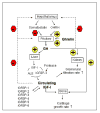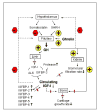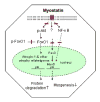The growth hormone-insulin-like growth factor-I axis in chronic kidney disease
- PMID: 17826224
- PMCID: PMC2706146
- DOI: 10.1016/j.ghir.2007.07.009
The growth hormone-insulin-like growth factor-I axis in chronic kidney disease
Abstract
Growth hormone (GH) and insulin-like growth factor-I (IGF-I) are important physiologic regulators of growth, body composition, and kidney function. Perturbations in the GH-IGF-I axis are responsible for many important complications seen in chronic kidney disease (CKD), such as growth retardation and cachectic wasting, as well as disease progression. Recent evidence suggests that CKD is characterized by abnormalities in GH and IGF-I signal transduction and the interaction of these pathways with those that involve other molecules such as ghrelin, myostatin, and the suppressor of cytokine signaling (SOCS) family. Further understanding of GH/IGF pathophysiology in CKD may lead to the development of therapeutic strategies for these devastating complications, which are associated with high rates of mortality and morbidity.
Figures




Similar articles
-
Inflammation and linear bone growth: the inhibitory role of SOCS2 on GH/IGF-1 signaling.Pediatr Nephrol. 2013 Apr;28(4):547-56. doi: 10.1007/s00467-012-2271-0. Epub 2012 Aug 11. Pediatr Nephrol. 2013. PMID: 22886280 Review.
-
Growth hormone axis in chronic kidney disease.Pediatr Nephrol. 2008 Jan;23(1):41-8. doi: 10.1007/s00467-007-0527-x. Epub 2007 Aug 5. Pediatr Nephrol. 2008. PMID: 17676425 Free PMC article. Review.
-
Comparison of GH, IGF-I, and testosterone with mRNA of receptors and myostatin in skeletal muscle in older men.Am J Physiol Endocrinol Metab. 2001 Dec;281(6):E1159-64. doi: 10.1152/ajpendo.2001.281.6.E1159. Am J Physiol Endocrinol Metab. 2001. PMID: 11701429 Clinical Trial.
-
Hepatic growth hormone resistance during sepsis is associated with increased suppressors of cytokine signaling expression and impaired growth hormone signaling.Crit Care Med. 2006 May;34(5):1420-7. doi: 10.1097/01.CCM.0000215113.66070.E0. Crit Care Med. 2006. PMID: 16540952
-
Growth Hormone and Insulin-Like Growth Factor Dysregulation in Pediatric Chronic Kidney Disease.Horm Res Paediatr. 2021;94(3-4):105-114. doi: 10.1159/000516558. Epub 2021 Jul 13. Horm Res Paediatr. 2021. PMID: 34256372 Review.
Cited by
-
Etiology and treatment of growth retardation in children with chronic kidney disease and end-stage renal disease: a historical perspective.Pediatr Nephrol. 2010 Apr;25(4):725-32. doi: 10.1007/s00467-009-1409-1. Epub 2009 Dec 24. Pediatr Nephrol. 2010. PMID: 20033735 Review.
-
Mechanism of earthquake simulation as a prenatal stressor retarding rat offspring development and chinese medicine correcting the retardation: hormones and gene-expression alteration.Evid Based Complement Alternat Med. 2012;2012:670362. doi: 10.1155/2012/670362. Epub 2012 Nov 26. Evid Based Complement Alternat Med. 2012. PMID: 23304210 Free PMC article.
-
Exploring metabolic dysfunction in chronic kidney disease.Nutr Metab (Lond). 2012 Apr 26;9(1):36. doi: 10.1186/1743-7075-9-36. Nutr Metab (Lond). 2012. PMID: 22537670 Free PMC article.
-
IGF-1 and IGFBP-3 in Inflammatory Cachexia.Int J Mol Sci. 2021 Aug 31;22(17):9469. doi: 10.3390/ijms22179469. Int J Mol Sci. 2021. PMID: 34502376 Free PMC article. Review.
-
Protective role of growth hormone against hyperhomocysteinemia-induced glomerular injury.Naunyn Schmiedebergs Arch Pharmacol. 2013 Jun;386(6):551-61. doi: 10.1007/s00210-013-0848-1. Epub 2013 Mar 27. Naunyn Schmiedebergs Arch Pharmacol. 2013. PMID: 23529346 Free PMC article.
References
-
- Mak RH. Chronic kidney disease in children: state of the art. Pediatr Nephrol. 2006 EPUB Nov 4. - PubMed
-
- Kaskel F. Chronic renal disease: A growing problem. Kidney Int. 2003;64:1141–1151. - PubMed
-
- Tonshoff B, Blum WF, Mehls O. Derangements of the somatotropic hormone axis in chronic renal failure. Kidney Int. 1997;S58:S106–S113. - PubMed
-
- Wuhl E, Schaefer F. Effects of growth hormone in patients with chronic renal failure: experience in children and adults. Horm Res. 2002;3:35–38. - PubMed
-
- Mak RH, Pak Y. End-organ resistance to growth hormone and IGF-I in epiphyseal chondrocytes of uremic rats. Kidney Int. 1996;50:400–406. - PubMed
Publication types
MeSH terms
Substances
Grants and funding
LinkOut - more resources
Full Text Sources
Medical
Miscellaneous

